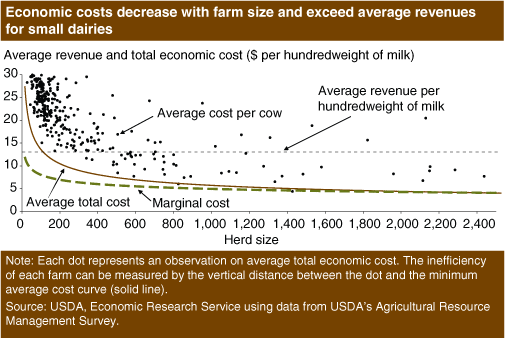Increasing Size of Dairy Farms Driven by Declining Production Costs
- by Roberto Mosheim
- 12/1/2009
Over the past three decades, the average herd size of U.S. dairy farms has increased from 29 to 139 head per farm. Decreases in average production costs in the U.S. dairy industry are driving this trend, which is projected to continue. ERS research shows that average total costs of U.S. dairy operations decline as farm size increases, even on farms with very large herds.
A closer look at the cost of producing an extra unit of dairy products (known as the marginal cost) and the average cost of producing a given amount of dairy products as herd size increases sheds light on why dairy operations are getting larger. As long as marginal costs are less than average costs, farms of all sizes, even the very largest, have an incentive to expand. When those costs are equal, the incentive is exhausted—at least until such farms adopt new technology. The largest farms have almost reached this point.
Farms with declining average costs, however, may not be operating at complete efficiency if costs exceed the industry’s minimum average total costs. A farm is “inefficient” if it fails to produce the maximum output with the inputs it employs, such as when a shortage of workers limits farm productivity. Inefficiency may also occur if an operation is not using inputs in optimal proportions given market prices; for instance, a farm cannot obtain credit to upgrade its technology and thus operates under an inefficient ratio of capital to labor. Farms of all sizes, but especially small ones, have room to improve their operational efficiency.
Many farms are not taking advantage of the incentives to expand. Some owners of small dairy operations may be unable to afford to hire a professional manager or outsource managerial responsibilities to family members and perform their own labor. This labor is valued at the wages the farmers could earn at paying jobs, and the forgone wages can often be very high. Owners of small operations may also be hindered by the costs necessary to adopt new technologies that could increase their efficiency and help lower average production costs. Moreover, even if fully efficient, the average farm with fewer than 135 cows is not fully covering its costs once the value of unpaid labor and implicit capital expenses are taken into account.
This article is drawn from:
- Scale Economies and Inefficiency of U.S. Dairy Farms. (2009). American Journal of Agricultural Economics. vol. 91, no. 3.


